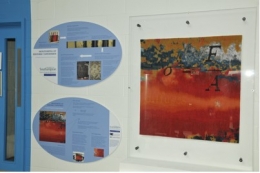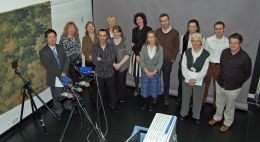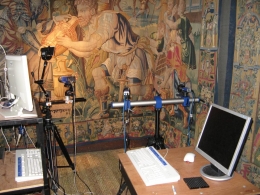Towards in-situ monitoring of tapestry degradation using strain-based engineering techniques
3 year project; PI Frances Lennard. AHRC Grant AH/D001404/1 (£386,000)
A dissemination event took place on 10 February 2010 to mark the end of this successful inter-disciplinary tapestry monitoring research project undertaken by researchers at the University of Southampton, from the Textile Conservation Centre (Frances Lennard, Principal Investigator, and Dr Dinah Eastop) and the School of Engineering Sciences (Professor Janice Barton and Dr Alan Chambers, Co-Investigators). Reports on the research and its outcomes were presented to and later discussed by representatives of the University of Southampton, other higher education institutions and industry partners such as the National Trust, English Heritage and Historic Royal Palaces. The research team members are grateful to the Institute of Archaeology, UCL for hosting the event.
The three-year project was funded by a grant of £386,000 from AHRC, the Arts and Humanities Research Council, and began in January 2007. It aimed to enhance the long-term preservation of tapestries by developing well-established engineering techniques to monitor the strain behaviour of tapestries, simply and unobtrusively, in situ. Strain, a measure of the percentage elongation of a material (Sahin et al, 2006), is assumed to lead to damage in the long term. The research set out to question whether tapestries are being pulled apart by their own weight, and also whether it is possible to identify incipient damage before it is visible to the naked eye.
The project objectives were to develop two techniques which an earlier pilot project had identified as the most promising for use on historic tapestries (Dulieu-Barton et al, 2005): optical fibre sensors to obtain point measurements of strain, and a whole-field measurement technique, digital image correlation. The final objective was to combine the two techniques into a hybrid system and use it to monitor tapestry samples in the laboratory, a newly woven tapestry and a historic tapestry in situ in a historic house.
Dr Chen-Chun Ye, the project’s Post-doctoral Researcher working on the optical fibre sensors in conjunction with Dr David Webb at the University of Aston, demonstrated that the novel technology of polymer fibre sensors had promising applications for monitoring textiles (Ye et al, 2009). The two PhD students, Djallal Khennouf and Helen Williams, validated and developed the technique of digital image correlation technique, in conjunction with the manufacturer LaVision, to the extent that it is a very useful tool (Khennouf et al, 2010). A series of tests showed that results from the two techniques validated each other and were reliable. It was also demonstrated that it was possible to identify areas of strain that were not obvious to the naked eye (Williams et al, 2009).
The techniques were trialled on specially commissioned tapestry panels woven at West Dean Tapestry Studio, then monitoring continued on a new tapestry, designed by the University’s Winchester School of Art students Rosalie Woods and Charlotte Agius, and also woven at West Dean. The tapestry is still on display at Intech Interactive Science Centre near Winchester, and has been monitored periodically in situ using both techniques. Optical fibres were both woven into the tapestry and bonded to the reverse. The culmination of the project was the on-site monitoring of a tapestry at Hardwick Hall, a National Trust property, over the summer of 2009. Useful results were obtained and the trial successfully overcame obstacles in transferring data to the University laboratory despite the lack of broadband signal at the property. The monitoring at Intech and Hardwick each provided useful opportunities for public dissemination; customised display materials were provided for display alongside the in situ monitoring and attracted a lot of visitor interest.
The monitoring carried out gave interesting results demonstrating the very close relationship between relative humidity (RH) and strain, with strain following changes in RH almost immediately. It is clear that strain increases as RH rises, perhaps because the tapestry gains weight as it absorbs more moisture. The rapid strain cycling of wool fabric samples, repeated 36,000 times, demonstrated how the material properties of the wool changed as a result; stress-strain curves showed that it had become a more brittle material after the loading. It is clear that there is a complex relationship between creep, the permanent deformation to a tapestry caused by hanging, and the damage caused by fatigue, or the constant expansion and contraction of fibres and yarns caused by fluctuations in RH. While this will not surprise conservators, this research has demonstrated that it is possible to quantify the strain and to begin to gain a better understanding of the mechanisms causing damage. In addition the digital image correlation technique generates colourful strain maps, which can be superimposed on the images of the tapestry, thereby providing an extremely useful tool for conservators, and for curators and other custodians, in explaining the way tapestries change. It is hoped that future work will be able to explore further the relationship between RH and strain, and that this will inform both preventive and interventive conservation techniques, e.g. by allowing a comparative study of lining and support techniques.
The researchers are very grateful to all those who supported the research, and in particular to members of the project’s advisory panel: Dr Paul Garside, British Library; Dr David Hollis, LaVision; Ksynia Marko, National Trust; David Thickett, English Heritage; Dr Constantina Vlachou, Historic Royal Palaces; Dr David Webb, University of Aston; Dr Christina Young, Courtauld Institute of Art.
References
Dulieu-Barton, J.M., Dokos, L., Eastop, D. E., Lennard, F. J., Chambers, A.R. and Sahin, M., “Deformation and strain measurement techniques for the inspection of damage in works of art” Reviews in Conservation, 2005, 6, pp 61-71.
Khennouf, D., Dulieu-Barton, J.M., Chambers, A.R., Lennard, F.J. and Eastop, D.E., “Assessing the feasibility of monitoring strain in historical tapestries using Digital Image Correlation”, Strain, 2010, 46, 19-32. DOI: 10.1111/j.1475-1305.2009.00637.
Sahin, M., Chambers, A.R., Dokos, L., Dulieu-Barton, J.M., Earl, J.S., Eastop, D. and Lennard, F., “Mechanical testing and its role in the condition assessment of tapestries”, In Tapestry Conservation: Principles and Practice (Eds. Lennard and Hayward), Butterworth-Heinemann, 2006, pp 227-234.
Williams, H.R., Dulieu-Barton, J.M., Chambers, A.R., Lennard, F. and Eastop, D., “Application of digital image correlation to tapestry and textile condition assessment”, AIC Textile Specialty Group, Los Angeles, May 2009, in press.
Ye, C.C., Dulieu-Barton, J.M., Webb, D.J., Zhang, C., Peng, G.-D., Chambers, A.R. Lennard, F.J. and, D.D.Eastop, “Applications of polymer optical fibre grating sensors to condition monitoring of textiles”, 20th International Conference on Optical Fibre Sensors, edited by Julian Jones, Brian Culshaw, Wolfgang Ecke, José Miguel López-Higuera, Reinhardt Willsch, Proc. of SPIE Vol. 7503, 75030M, 2009, pp 0M1-0M4.



